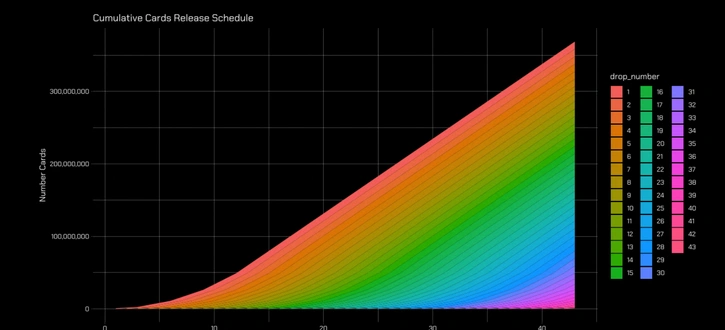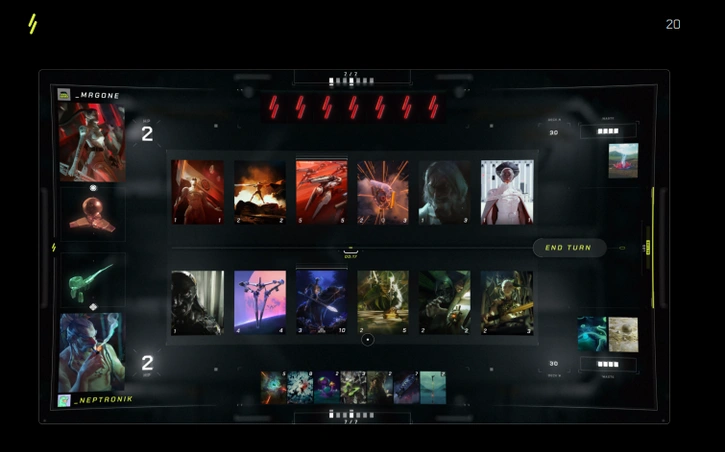5 Key Takeaways From Parallel Alpha's Prime Proposal

On January 25, Parallel Alpha - a science fiction trading card game (TCG) being built on the blockchain - finally dropped their long-awaited Prime Proposal and an accompanying Echelon Paper to detail Parallel Studio's goals and vision for the long term future of the NFT based card game. At 42-pages long, the document covers a wide range of topics and contained key insights into how the future of Parallel Alpha will be played and governed. Below is a quick recap of some of the most important mentions and gameplay mechanics released in this document. Further analysis similar to this summary will can be found here for the Echelon Paper, that contains most of the token economics surrounding the community.
1. Parallel Is Just the Beginning of the Prime Foundation Ecosystem
The Prime Proposal states clearly, that it is meant to be a "living document" which directly looks at Parallel Trading Card Game as the first game in a suite of games and web3 tools that will make up the Prime Foundation Ecosystem. Essentially Parallel Studios intends to flesh out their team and community beyond just Parallel in the future, with their token $PRIME being the centerpiece for the ecosystem's economics.
The Echelon Whitepaper breaks down specifics on the $PRIME Token and its distribution which you can read here, but for now let's dive in to what the Prime Proposal states about Parallel's plan for the Trading Card Game.
2. Card Dynamics in Parallel
The Proposal starts on the topic of Digital Assets, which in large part will dominate the ecosystem, but Parallel intends for users to derive value from various sources. Parallel aims to create a popular "PlayFi experience where players can not only earn from in-game winnings, but through staking NFTs and $PRIME tokens, card sharing, market activity rewards, and more." With this goal in mind the team addresses the issue of card balancing. With access to certain rare cards currently gated by price barriers, Parallel has proposed three ways to ensure an equal playing field while maintaining scarcity of the original First Edition (FE), Special Edition (SE), and Perfect Loops (PL) cards. The following mechanisms were proposed by Parallel:
Card Continuum (CC): A Parallel initiated run of cards that would increase the supply of a given card set depending on demand and player base size according to the chart below. If enacted by the community via governance vote, Card Continuum cards will feature a mark denoting which CC version they belong to. A CC version may also have slightly different art, card frame, and other identifying features in order to distinguish it from the First Edition version of the playable card.
Lineage System: The second proposed idea is a card progression and spawning system which would allow players to level up their cards through winning games and spending $PRIME to make copies to be sold on secondary markets. This would naturally increase supply without Parallel's influence allowing the community to organically determine scarcity. Each time a card is used to spawn a new copy, a cooldown would start that can only be advanced with additional wins. System designers will not have to predict player base growth in this method and cards within the linage system would be denoted "spawned" much like CC, differentiating them from current FE, SE an PL cards.
Apparitions: A smaller third proposal allows for physical cards which could be used in a similar manner to a starting deck like in Magic the Gathering Arena or Hearthstone. These packs would be sold at a fraction of the price and could help onboard new players and help existing players round out decks for in-game use.
3. Keys, Collectibles and Other Digital Assets
After addressing the supply concerns and scalability of Parallel Trading Card Game, the Prime Foundation offers some clarity on the other types of NFT cards they have released and the uses cases. Between card backs, masterpieces, and keys - the game has multiple digital assets that now have proposed mechanics. The following describe each assets specific utility within the $PRIME ecosystem.
- PRIME KEYS: The only assets the community previously knew the utility of. Prime Keys act as pack reservations but in addition to this they can be staked for $PRIME, can be used to redeem giveaways, and will also open up additional slots in the new key framing system.
- GALAXY KEYS: Galaxy Keys will grant access to a special Galaxy Faucet that will open periodically. In the Key Framing system, Galaxy Keys will increase the in-game $PRIME emission during gameplay by a random amount.
- OVERCLOCK KEYS: Overclock Keys are utilized in Key Framing and dramatically increase PRIME earnings from consecutive wins.
- CATALYST AND PRIME DRIVE: Both Catalyst and Prime Drive cards are asset cards. Submitting both a Catalyst Drive and a Prime Key to the designated smart contract will combine them into a Prime Drive. When staked, Prime Drives will enable a user to claim a portion of $PRIME periodically from the Echelon Cornerstone.
- THE CORE: Also an asset card in the Parallel collection that when staked will enable a user to claim a portion of $PRIME periodically from the Echelon Cornerstone staking pool.
- MASTERPIECES: Parallel Masterpieces are 1-of-1 NFTs. There is one Masterpiece for each piece of card art in the game. When staked, Masterpieces will enable a user to claim a portion of $PRIME periodically from the Echelon Cornerstone staking pool.
- CARD BACKS: Card Backs are limited edition in-game items that alter what the back of cards look like during play.
After reviewing most of the utility, many are tied to the in-game currency $PRIME and earning more of it through different play styles and avenues. This is a positive sign for any who wants to interact with the Parallel Trading Card Game on deeper than surface-level gameplay mechanics.
4. $PRIME and Game Sinks
With $PRIME having a fixed supply of 111,111,111.111 the question then becomes what utilizations and value proposition does the token supply. With various initial propositions, the list below details the ideals that the Parallel Team wants to implement for the 30% of initial $PRIME supply designated for gaming utility.
One other thing to note is as other games begin to launch on the Echelon ecosystem, they will bring with them their own set of Game Sinks. With a wide array of specific card utility and game sinks proposed, the Parallel team shifts their focus to deeper gameplay mechanics in the back half of this document, leaving details to token distribution to the Echelon Foundation Whitepaper.
5. Gameplay/Echelon Ecosystem
This section takes up a decent portion on the second half of the document that details specifics regarding game modes, card leveling, and other products within the ecosystem that will facilitate these actions. If interested, pages 17 - 21 contain most of the details regarding rewards and other gameplay mechanics, but the following is a quick list of the main points regarding each feature within the suite.
- Gameplay Rewards: During regular gameplay person vs. person (PvP) there will be $PRIME rewards omitted upon a player winning the game. The reward system is as follows: WIN PAYOUT = TIME_BASED_EMISSION + LADDER_REWARDS + KEY_BONUSES [+ NFT_BONUS]. Based on a set of declining functions the reward system seems to be meticulously crafted to reward early adopters, high skilled players, and consistent competitors alike.
- Game Modes: The team has proposed a set of game modes that can help facilitate organic user growth through various avenues of play. Each game mode is intended to not pigeonhole consumers to strictly competitive gameplay.
- Ladder Mode: Ladder games are strictly one verse one, where your rank will be impacted by match outcomes. In addition to outcome-based $PRIME earnings, in-game rewards, such as cards or in-game cosmetics, will be issued at the end of a monthly season based on a player’s standing.
- Sectors: Sectors is a meant to be a replayable game mode that offers both single player and multiplayer experiences. In this format, players will construct an initial 30-card deck based on a choice of 10-card sets that are offered at the beginning of a run. Players will be able to earn PRIME in the multiplayer Sectors format.
- Rookie Queue: This is meant to onboard players into the Parallel TCG universe. The "Rookie Decks" will be available to players to learn and casually experience what the game has to offer.
- Key Framing: Key Framing will be a system that allows players to uses various types of digital assets such as Keys, described earlier, to modify their $PRIME emissions during winning matches. Essentially each Key has different characteristics that can be swapped into slots to help earn more PRIME through actions such as consecutive wins or playing their favorite cards.
- Staking: Although only slightly mentioned staking will be available for each card, rewarding users with $PRIME in a distribution system broken down in the Echelon Whitepaper.
- INb0x & Bonds: These two features will be built outside the game but within the Echelon Ecosystem that can verify information within the Parallel game. Inb0x, a messaging service previously teased, will facilitate secure discussion between players that want to trade, sell, or buy cards. This system will verify owners and holders of each digital asset within the ecosystem. Bonds in a similar fashion will facilitate discussion and groups between active players. Being able to trade between friends and borrow cards or share information Bonds will work such as a community that has leaderboards, and other premium features that will cost PRIME.
- String: This is a system that will connect digital assets to physical redeemable assets. The main point of this service is to allow users to safely claim physical assets that are tied to the digital cards, as well as verify whether the cards being purchased are still available for physical redemption.
- Individualization: In the last feature outlined by the team, current ERC-1155 token holders will be able to convert their card(s) into ERC-721 versions of the same card. This will cost PRIME but will allow you to connect the card to an oracle that will review data on how the card is played and further in-game experience upgrades as the player wins matches with it.
Final Thoughts
The Prime Proposal sheds light on a whole host of topics that the community has been speculating on since the first pack drop. With the gameplay in development and most of the systems outlined here, the Echelon Ecosystem has a clear goal for the future of Parallel and the wider landscape surrounding the $PRIME economy. The effort to build a large-scale, popular trading card game has a clear roadmap now, and the execution will be highly anticipated in the coming months as PDIII is the final drop before alpha release. Refer to our breakdown on the Echelon Whitepaper and the deeper $PRIME token economics and distribution as the community begins to grasp the totality of everything the Prime Proposal had to offer.
Additional Resources
Prime Proposal & Echelon Whitepaper
Disclaimer: Lucky Trader is not a registered investment advisor. You understand that the service is furnished for your personal noncommercial, information, purpose only. No mention of an NFT in the service constitutes as a recommendation to buy, sell, or hold that or any other NFT. Nothing within the service shall, or is intended to, constitute financial, legal, accounting, or tax advice. Any decision that you make to buy, sell, or hold an NFT should be based on an assessment of your risks in consultation with your personal advisers.

